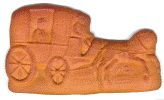Origins
The origins of the “Coques” (sort of big biscuit or cookie) of Dinant goes back to the XV century during the siege of the town by Charles the Téméraire (1466). The Dinantais, deprived of provisions only had honey and flour, thought to make a dough and cook it. This paste, being very firm, they pressed it into the Dinandries (moulds used by local craftsmen) and obtained very varied designs.
Fabrication
 Ancient
Ancient
In this period the dough was kneaded by hand in a wooden bowl called a “maie” and then flattened with a pastry roller to obtain the wanted thickness. This dough was then cut to give it its general form before being placed in a mould where it was pressed. The pressing was still done by hand. The coques, well laid out on trays, were cooked the next day in wood fired oven, then later, in a coal fired oven.
Present
The ‘maie’ has been replaced by an electrical machine. The pastry roller has been replaced by an electric conveyor belt; to steel rollers turning opposite ways flatten the dough to the desired thickness. Today the coques are still pressed in wooden moulds, hand made from pear tree wood, and represent numerous subjects, landscapes, fruit, animals and characters of differing sorts and sizes. The cooking now takes places in diesel heated ovens with the temperature varying from 250°c to 320°c depending on the thickness of the coques.
Ingredients
The Dinant coques are made from honey and wheatflour. The honey is imported from countries like Cuba, Mexico……etc. As for the so called coque of “Rins”they are made from the same products to which is added some sugar. Why is it called “coques de Rins”? Francois Rins was the first pastry cook from Dinant to have the idea to incorporate the sugar to the mixture of honey and wheatflour; this is how his name became associated with this new speciality.
Wrapping and conservation
On coming out of the oven the “coques” have to cool, flat, on big tables before being put into wooden boxes ( metal on the inside ) to keep them from the humidity. As and when sold to the shops, the “ couques” are taken from the wooden boxes and put in cellophane bags and sold individually, whereas sold in bulk, they are sold by the kilo.
In the summer, during the tourist season,the number of sales are quite large, but it is really around the St. Nicolas that they are at maximum. It’s to the whole of Belgium that the “coques” from Dinant and of ‘Rins’ are then sent to be sold in many patisseries and shops.
| To visit a producer of “coques” | |||
|---|---|---|---|
| Etablissement
V. COLLARD fondés en 1774 rue de Maibes et rue En Rhée,24 5500 DINANT Tel : 082/22 38 36 Visits : on appointment |
Maison
GIGOT, successeur PIROT rue Léopold, 9 5500 DINANT Tel : 082/22 22 09 Visits : on Wednesday and Thursday from 2pm |
Maison
JACOBS Tel/fax : 082/22.21.39 Visits : on appointment |
Maison
THONON rue des Orfèvres, 15 5500 DINANT Tel : 082/22 31 14 Visits : on appointment |